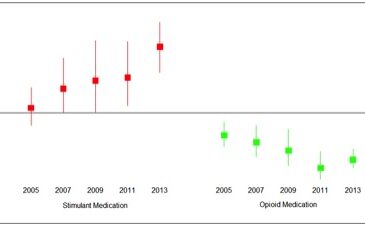College environments are always undergoing change. Universities renovate old facilities or build new ones. Administrators may release previous years’ instructors or hire new instructors. Faculty tries out new curricula and courses. Each specific change in a college environment might be associated with other broader changes. For example, student substance use – in both the choice of drugs and the reasons for use – could change as older students leave and younger students enroll. This week, the STASH reviews a cross-sectional study that examines changes in non-medical use of prescription drugs among college students (McCabe et al., 2014).
Methods
- During the winter semesters of 2003, 2005, 2007, 2009, 2011, and 2013, the researchers surveyed randomly sampled full-time undergraduates at a large public research university in the Midwest United States.
- In a web-based survey, participants reported on demographic data and lifetime and past-year medical and non-medical use of four classes of prescription drugs: sleeping medication, sedative/anxiety medication, stimulant medication, and opioid/pain medication.
- The researchers used multiple logistic regressions to assess possible associations between past-year non-medical use of each class of drugs and year of the survey, along with other factors. Here, we report associations between year of the survey and non-medical prescription use.
Results
- As Figure 1 indicates, students in more recent years were more likely to report past-year non-medical use of stimulants than students in 2003. For example, 2013 students were 1.6 times more likely to report non-medical use of stimulants than students in 2003.
- On the other hand, students in more recent years were less likely to report past-year non-medical use of opioid medication than students in 2003. For example, 2013 students were about half as likely to report non-medical use of opioids than students in 2003 .
- There was no significant upward or downward trend in non-medical use of either sleeping medication or sedative/anxiety medication.
Figure. Unadjusted odds ratios (boxes) and 95% confidence intervals (lines) for survey years for stimulant medication and opioid medication. Odds ratios above 1.0 with confidence intervals that do not include 1.0 represent an increase in non-medical use of prescription stimulants compared to 2003. Odds ratios below 1.0 with confidence intervals that do not include 1.0 represent an decrease in non-medical use of prescription stimulants compared to 2003. Adapted from McCabe et al. (2014). Click image to enlarge.
Limitations
- This survey was limited to a single large public university. The results may not generalize to other similar large schools, or smaller schools and private universities.
- Most of the data, including the levels of non-medical and medical use of prescription drugs, were self-reported. Participants’ answers may have been biased by their memory or by their personal attitudes about the use or abuse of these drugs.
- The study methodology precludes identification of the causes of cohort differences. We can conclude that students’ use of these drugs changed over time, but we do not know why these changes occurred.
Conclusion
As the college environment changes, so do the problems that college students face, and as such, so do the methods they might use to attempt to deal with these problems. If the motivations for using drugs changes over time, then it is reasonable to believe that the choice of drugs will change over time also. If researchers and administrators can detect these changes and work backwards to their root causes, perhaps they can find better ways to serve college students’ needs.
— Matthew Tom
What do you think? Please use the comment link below to provide feedback on this article.
Reference
McCabe, S. E., West, B. T., Teter, C. J., & Boyd, C. J. (2014). Trends in medical use, diversion, and nonmedical use of prescription medications among college students from 2003 to 2013: Connecting the dots. Addictive Behaviors, 39(7), 1176–1182. doi:10.1016/j.addbeh.2014.03.008





